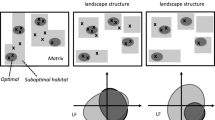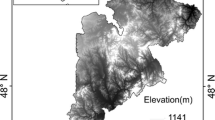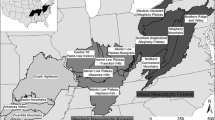Abstract
Habitat configuration has important implications for the persistence of faunal and floral populations at a variety of spatial scales. Forest harvesting alters habitat configurations. However, measuring and predicting such alterations remains challenging, in part because previously developed metrics of habitat configuration are often not statistically independent of habitat amount. Thus, their ability to measure independent effects of habitat configurations and habitat amount on ecosystem components such as wildlife populations has been limited. Here, we evaluate habitat configuration based on newly developed metrics that are independent of habitat amount but do not depend on regression residuals of abundance and configuration relationships on any population of landscapes. We use these new metrics to measure and predict changes in habitat configuration following forest harvesting in the boreal forest of Alberta, Canada. Our findings clearly demonstrate changes in habitat configuration resulting from forest harvesting can be predicted precisely with information about initial habitat patch structure and harvesting patterns. Because forest harvesting has significant implications for habitat configuration, accurately predicting these changes is critical for determining if forest harvesting strategies are sustainable for ecosystem components and processes. This study provides a set of novel, robust metrics for tracking landscape-scale changes in habitat configuration in harvested boreal forests.





Similar content being viewed by others
References
Andrén H (1994) Effects of habitat fragmentation on birds and mammals in landscapes with different proportions of suitable habitat: a review. Oikos 71:355–366. doi:10.2307/3545823
Burton PJ, Messier C, Weetman GF, Prepas EE, Adamowicz WL, Tittler R (2003) The current state of boreal forestry and the drive for change. In: Burton PJ, Messier C, Smith DW, Adamowicz WL (eds) Towards sustainable management of the boreal forest. NRC Research Press, Ottawa, pp 1–40
Buyantuyev A, Wu JG (2007) Effects of thematic resolution on landscape pattern analysis. Landscape Ecol 22:7–13. doi:10.1007/s10980-006-9010-5
Cumming SG (2001) Forest type and wildfire in the Alberta boreal mixedwood: what do fires burn? Ecol Appl 11:97–110. doi:10.1890/1051-0761(2001)011[0097:FTAWIT]2.0.CO;2
Cumming SG, Armstrong GW (2001) Divided land bases and overlapping forest tenure in Alberta, Canada: a simulation study of the costs of forest policy. For Chron 77:501–508
Cumming SG, Vernier P (2002) Statistical models of landscape pattern metrics, with applications to regional scale dynamic forest simulations. Landscape Ecol 17(5):433–444. doi:10.1023/A:1021261815066
D’Eon RG (2002) Forest fragmentation and forest management: a plea for empirical data. For Chron 78(5):686–689
D’Eon RG, Glenn SM (2005) The influence of forest harvesting on landscape spatial patterns and old-growth-forest fragmentation in southeast British Columbia. Landscape Ecol 20:19–33. doi:10.1007/s10980-004-0286-z
Fahrig L (1997) Relative effects of habitat loss and fragmentation on population extinction. J Wildl Manag 61:603–610. doi:10.2307/3802168
Fahrig L (1998) When does fragmentation of breeding habitat affect population survival? Ecol Modell 100:273–292. doi:10.1016/S0304-3800(97)00163-4
Franklin JF, Forman RTT (1987) Creating landscape patterns by forest cutting: ecological consequences and principles. Landscape Ecol 1:5–18. doi:10.1007/BF02275261
Gardner RH, Lookingbill TR, Townsend PA, Ferrari J (2008) A new approach for rescaling land cover data. Landscape Ecol 23:513–526. doi:10.1007/s10980-008-9213-z
Gustafson EJ, Crow TR (1994) Modeling the effects of forest harvesting on landscape structure and the spatial distribution of cowbird brood parasitism. Landscape Ecol 9(4):237–248. doi:10.1007/BF00129235
Hanski I (1999) Metapopulation ecology. Oxford University Press, Oxford
He HS, Mladenoff DJ, Gustafson EJ (2002) Study of landscape change under forest harvesting and climate warming-induced fire disturbance. For Ecol Manag 155:257–270. doi:10.1016/S0378-1127(01)00563-1
Hobson KA, Schieck J (1999) Changes in bird communities in boreal mixedwood forest: harvest and wildfire effects over 30 years. Ecol Appl 9(3):849–863. doi:10.1890/1051-0761(1999)009[0849:CIBCIB]2.0.CO;2
Jones JA, Grant GE (1996) Peak flow responses to clear-cutting and roads in small and large basins, western Cascades, Oregon. Water Resour Res 32(4):959–974. doi:10.1029/95WR03493
Koper N, Schmiegelow FKA, Merrill EH (2007) Residuals cannot distinguish between ecological effects of habitat amount and fragmentation: implications for the debate. Landscape Ecol 22:811–820. doi:10.1007/s10980-007-9083-9
Li H, Reynolds JF (1995) On definition and quantification of heterogeneity. Oikos 73:280–284. doi:10.2307/3545921
Lowe WH (2002) Landscape-scale spatial population dynamics in human-impacted stream systems. Environ Manag 30(2):225–233. doi:10.1007/s00267-001-2687-y
McGarigal K, McComb WC (1995) Relationships between landscape structure and breeding birds in the Oregon coast range. Ecol Monogr 65:235–260. doi:10.2307/2937059
McGarigal K, Cushman SA, Neel MC, Ene E (2002) FRAGSTATS: spatial pattern analysis program for categorical maps. Computer software program produced by the authors at the University of Massachusetts, Amherst. Available from: www.umass.edu/landeco/research/fragstats/fragstats.html
Meyer JS, Irwin LL, Boyce MS (1998) Influence of habitat abundance and fragmentation on spotted owls in western Oregon. Wildl Monogr 139:1–51
Neter J, Kutner MH, Nachtsheim CJ, Wasserman W (1996) Applied linear statistical models, 4th edn. Irwin, Chicago
O’Neill RV, Hunsaker CT, Jackson BL, Jones KB, Riiters KH, Wickham JD (1996) Scale problems in reporting landscape pattern at regional scale. Landscape Ecology 11:169–180
Remmel TK, Csillag F (2003) When are two landscape pattern indices significantly different? J Geogr Syst 5:331–351. doi:10.1007/s10109-003-0116-x
Rempel RS, Baker J, Elkie PC, Gluck MJ, Jackson J, Kushneriuk RS, Moore T, Perera AH (2007) Forest policy scenario analysis: sensitivity of songbird community to changes in forest cover amount and configuration. Avian Conserv Ecol—Écol Conserv Oiseaux 2(1):5. [online] URL: http://www.ace-eco.org/vol2/iss1/art5/
Schmiegelow FKA, Hannon SJ (1993) Adaptive management, adaptive science, and the effects of forest fragmentation on boreal birds in northern Alberta. In: Transactions of the 58th North American wildlife and natural resources conference, pp 584–598
Schmiegelow FKA, Machtans CS, Hannon SJ (1997) Are boreal birds resilient to forest fragmentation? an experimental study of short-term community responses. Ecology 78(6):1914–1932
Schmiegelow FKA, Stepnisky DP, Stambaugh CA, Koivula M (2006) Reconciling salvage logging of boreal forests with a natural-disturbance management model. Conserv Biol 20:1523–1739
Simon NPP, Schwab FE, Otto RD (2002) Songbird abundance in clear-cut and burned stands: a comparison of natural disturbance and forest management. Can J For Res 32:1343–1350. doi:10.1139/x02-057
Tang SM, Franklin JF, Montgomery DR (1997) Forest harvest patterns and disturbance processes. Landscape Ecol 12:349–363. doi:10.1023/A:1007929523070
R Development Core Team (2006) R A language and environment for statistical computing, reference index Version 2.3.1. R Foundation for Statistical Computing, Vienna. ISBN 3-900051-12-7, http://www.R-project.org
Thompson B (1995) Stepwise regression and stepwise discriminant analysis need not apply here: a guidelines editorial. Educ Psychol Meas 55(4):525–534. doi:10.1177/0013164495055004001
Trzcinski MK, Fahrig L, Merriam G (1999) Independent effects of forest cover and fragmentation on the distribution of forest breeding birds. Ecol Appl 9:586–593. doi:10.1890/1051-0761(1999)009[0586:IEOFCA]2.0.CO;2
Vernier P, Schmiegelow FKA, Cumming SG (2001) Modeling bird abundance from forest inventory data in the boreal mixedwood forests of Canada. In: Scott JM, Heglund PJ, Morrison M, Raphael M, Haufler J, Wall B (eds) Predicting species occurrences: issues of scale and accuracy. Island Press, Covella
Vernier PR, Schmiegelow FKA, Hannon S, Cumming SG (2008) Generalizability of songbird habitat models in boreal mixedwood forests of Alberta. Ecol Modell 211(1–2):191–201. doi:10.1016/j.ecolmodel.2007.09.004
Villard M, Trzcinsky MK, Merriam G (1999) Fragmentation effects on forest birds: relative influence of woodland cover and configuration on landscape occupancy. Conserv Biol 13:774–783. doi:10.1046/j.1523-1739.1999.98059.x
Wallin DO, Swanson FJ, Marks B (1994) Landscape pattern response to changes in pattern generation rules: land-use legacies in forestry. Ecol Appl 4:569–580. doi:10.2307/1941958
Wilcove DS, McLellan CH, Dobson AP (1986) Habitat fragmentation in the temperate zone. In: Soulé ME (ed) Conservation biology. Sinauer, Sunderland, pp 237–256
Wu JG (2004) Effects of changing scale on landscape pattern analysis: scaling relations. Landscape Ecol 19:125–138. doi:10.1023/B:LAND.0000021711.40074.ae
Acknowledgments
This research was supported by the Boreal Ecology and Economics Synthesis Team (BEEST), under a grant from the Sustainable Forest Management Network. We thank Drs. Xinsheng Hu, Petro Bakak, and Dan Mazerolle of the Department of Renewable Resources, University of Alberta for their valuable suggestions and discussions; Trish Fontaine for her GIS assistance; Dr. Rob D’Eon for editorial assistance; and Alberta Pacific Forest Industries Inc. for provision of digital inventory data.
Author information
Authors and Affiliations
Corresponding author
Rights and permissions
About this article
Cite this article
Wang, X., Cumming, S.G. Modeling configuration dynamics of harvested forest landscapes in the Canadian boreal plains. Landscape Ecol 24, 229–241 (2009). https://doi.org/10.1007/s10980-008-9301-0
Received:
Accepted:
Published:
Issue Date:
DOI: https://doi.org/10.1007/s10980-008-9301-0




